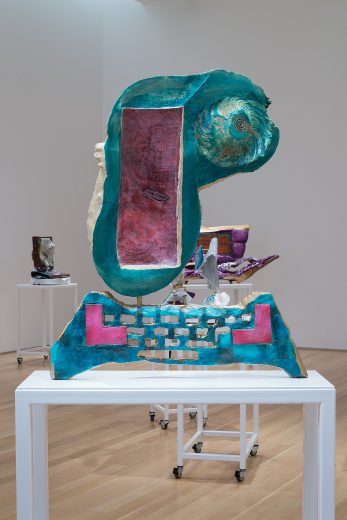Prairie Studies Initiative
During fiscal year 2017 the Prairie Studies Initiative (PSI) has continued on-going projects such as the Meadow and the hosting of the annual Tall Grass Artist Symposium, and undertaken new ones as well. Touch the Prairie, an interactive touch screen that links prairie-related artworks in the museum’s collection with natural science information about the prairie ecosystem, has taken on a double life. Programmer/artists Rose Marshack and Rick Valentin were able to further develop Touch the Prairie for installation on a large upright mobile touch screen. The creative work and equipment purchase were made possible by a gift from Jackie Hartman Borck and Lee Borck. The mobile touch screen was unveiled April 1, 2017 on the occasion of K-State Open House, and is now available to visitors in the museum’s galleries. We hope you will check it out on your next visit to the museum.
The touch table, its original platform, will ultimately return to the Department of Landscape Architecture/Regional and Community Planning. Before that, the interactive table will spend the academic year 2017-18 at the offices of the Kansas Board of Regents in Topeka as part of a display titled “Artistry and Innovation” representing the creative cross-disciplinary work of Kansas State University.
A suite of six high resolution photographs of prairie plants with their exceptionally long roots by Lindsborg-based photographer Jim Richardson has become part of the museum’s permanent collection. Two of these prints were part of the reinstallation of the permanent collection, opened last fall as part of a celebration of the 20th anniversary of the Marianna Kistler Beach Museum of Art.
In May the museum took the lead role in submitting a proposal to the National Endowment for the Arts titled, “What can the arts teach us about communicating STEM content?” Associate Professor Shreepad Joglekar of the department of Art and I serve as co-principle investigators. The Salina-based Land Institute is our required non-arts partner organization; key support for the proposal comes from Todd Holmberg, executive director of McCain Performing Arts, and Dean of Libraries Lori Goetsch. The strong place-based and cross disciplinary focus of proposal activities make it an exciting next step for PSI. Fingers crossed!
– Linda Duke, Director
